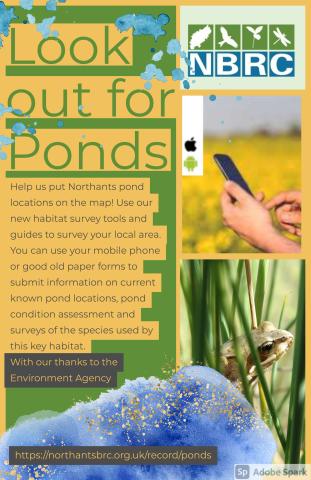
We are firmly heading into the ideal ‘maximum pond boundary’ gathering season for our ‘Look out for …Ponds’ Survey. Knowing the area of each pond aids us to map the water resources for our wildlife and feed into species modelling. Crucially, for Northants, this is 'missing information' so all data submitted on all ponds, big and small, help manage habitats for species.
We are looking to fill the map with our known ponds (and the species who rely in them!). Our ‘Look out for..... Ponds' is the first habitat based focal survey we have run, building on the successes of the species ‘look out for's' that you took part in to generate data on bee fly, badgers, mistletoe…the list keeps growing! We want to apply this ‘gaps in the maps’ model to a missing habitat.
Ponds are easily recognisable and incredibly important features of our landscape. However we currently do not have comprehensive information coverage of their locations. You can take part with basic information - a name, date and location, submitted by paper or via our app. The full survey information requested can be used assess water quality, habitat suitability (for great crested newt particularly) and understand the natural resources that support everything from plants, to water bugs to birds.
Understanding where these habitats are distributed throughout the county, and any supporting information on their current condition arms us with the tools to inform landscape scale approach for species conservation. We have developed, with Environment Agency support, both paper based and mobile app based survey tools to report and gather this information.
Submissions are welcome via either method, and you can use them together - you may find the paper form useful to prepare for information requested. The mobile epicollect form will generate a GPS location using your phone (as will be validated against the location information you provide). It will also allow photos, taken on site via your phone camera, to be added to your survey. Most of the mobile survey form fields are set up as optional, so you can submit what you know, upwards from basic location information.
Download our Survey Guide and Risk assessment to get started
Starting in winter when ponds are at their fullest (after the rains) gives you the opportunity to provide an accurate maximum pond area at the easiest time of the year. At other times you can still submit this but you will need to look at clues such as marks on the rocks and vegetation to determine this information. This can be submitted as a drawing on a OS map, by creating and submitting a GPS unit track file (where safe to do so) or if particularly techy and you use to QGIS, you can request our QField project.
We see this survey as an all year project. A real 'adopt a pond' monitoring approach with interest from return visits in spring and summer to tell us the species you find within and around your reported ponds. The more we know, the better our local habitats can be managed.

